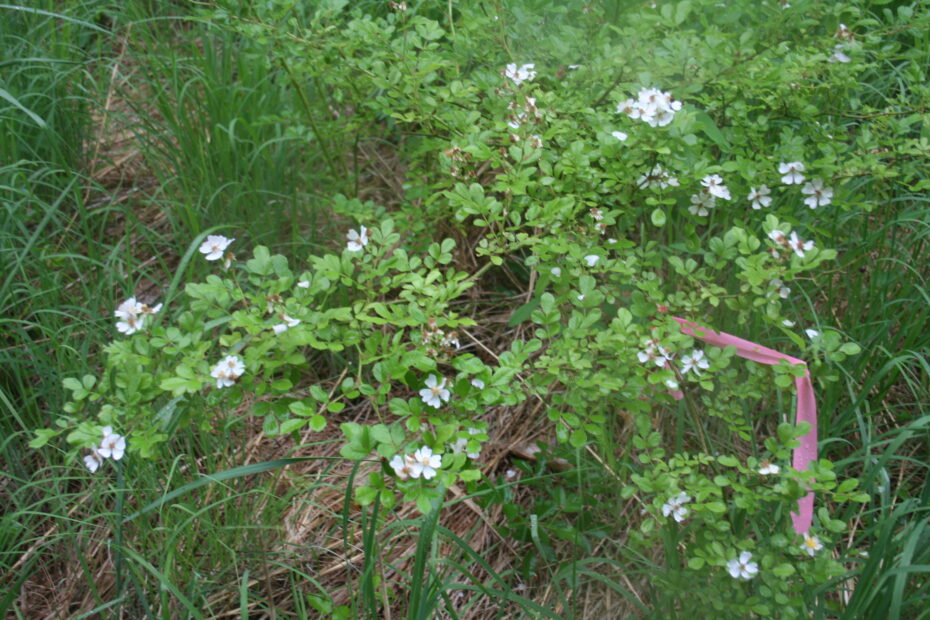It’s been almost 18 months since we put up our game cameras and started to see all kinds of animals living, raising families, and thriving on the Beede Site. This kind of diversity was unexpected. However, since Site operations ended in the mid-90s, we’ve seen the return of wildlife to much of the Site.
Pine trees that were once just saplings have grown to great heights and created a habitat beneath their boughs, supporting a forest floor cover, including wintergreen, fungi, and Indian pipe flowers. Showy tick trefoil, bristly sarsaparilla, and whorled loosestrife provide a food source for various pollinators. Blueberry bushes feed birds and animals all summer, while the winterberry bushes take over during the long winter months, and the acorns from red and white oak trees provide food for squirrels and other animals.
But there is a growing threat to the native environment – invasive and non-native plant species.
Well-established, healthy environments allow native plant species to thrive, but disturbances to the soil alter its original characteristics which can introduce seeds, root fragments, or other viable plant parts to the ecosystem. Often first appearing on roadsides, construction sites, and in fields, invasive and non-native plant species are aggressive growers because they produce a lot of seeds, can tolerate a variety of environmental conditions, and have few natural predators or controls. Once those plants become established, they can reduce native species diversity, damage personal property, and worst of all, diminish the presence of wildlife by taking away necessary food sources.
Here on the Beede Site, we’ve found 11 species of invasive plants. Now that we have identified the species, we can figure out how to slow and hopefully control their spread to minimize the impact across the property.
Curious how you can help control the spread of these species in Plaistow? First, look around your property to see if you observe any invasive or non-native species. Not sure what they look like? Here are some common ones to keep an eye out for.
Multiflora Rose

A variety of rose, this species is often seen growing in clumps or climbing vertically, using other plants or trees as scaffolding. Their leaves begin to appear in May or June with red berries appearing in August and persisting throughout the winter months. A single plant can produce up to 500,000 seeds, each of which remains viable between 10 and 20 years depending on soil conditions.
Asiatic Bittersweet

Known for its vine-like structure, Asiatic bittersweet grabs hold of and climbs anything it can use as scaffolding as it reaches for light, oftentimes, twining upon itself, killing the trees it wraps around, or becoming entangled in power lines and utility poles. Bright yellow seeds appear in early July and slowly begin to shed their yellow outer shell to reveal bright red berries on the interior. As autumn approaches, bittersweet leaves become bright yellow and gold. When pulled from the ground, bittersweet has a characteristic orange root system that, if not managed correctly, can re-grow simply by remaining in contact with the ground.
Autumn Olive

This large shrub has two very distinguishing features – the first is fragrant, creamy white or yellow flowers that appear in the spring and transforming into bright red berries in the fall, and the second is the silvery-green shimmer on the underside of the leaves.
If you identify these, or other invasive or non-native plant species on your property and the volume is small enough to manage on your own you should research the most appropriate management technique. Some plants can be simply dug out at the root while others may require the application of an herbicide. Be sure to follow local, state, and federal laws regarding herbicide application, and if you have questions, contact a State-licensed applicator.
Removing invasive plant material yourself may seem a little daunting, but the best strategy is to kill the viable plant material including foliage and seeds by piling plant debris on a tarp in the sun and then covering the pile with another tarp. Don’t pile any newly cut brush in the woods because that could lead to further spread. In the state of New Hampshire, it is illegal to transport invasive species off the property where they originated, so it is often best to contact your town for additional information on proper disposal.
As with most things, your best tool in the fight against invasive and non-native species is knowledge. Before planting anything new, talk with your local garden center or landscaper about native plant options. Avoid purchasing holiday decorations that contain natural components without knowing what they are because many wreaths contain berries and leaves that are the product of an invasive plant species like Asiatic bittersweet or multiflora rose.
Want to learn more about invasive species in New Hampshire? Click here.
